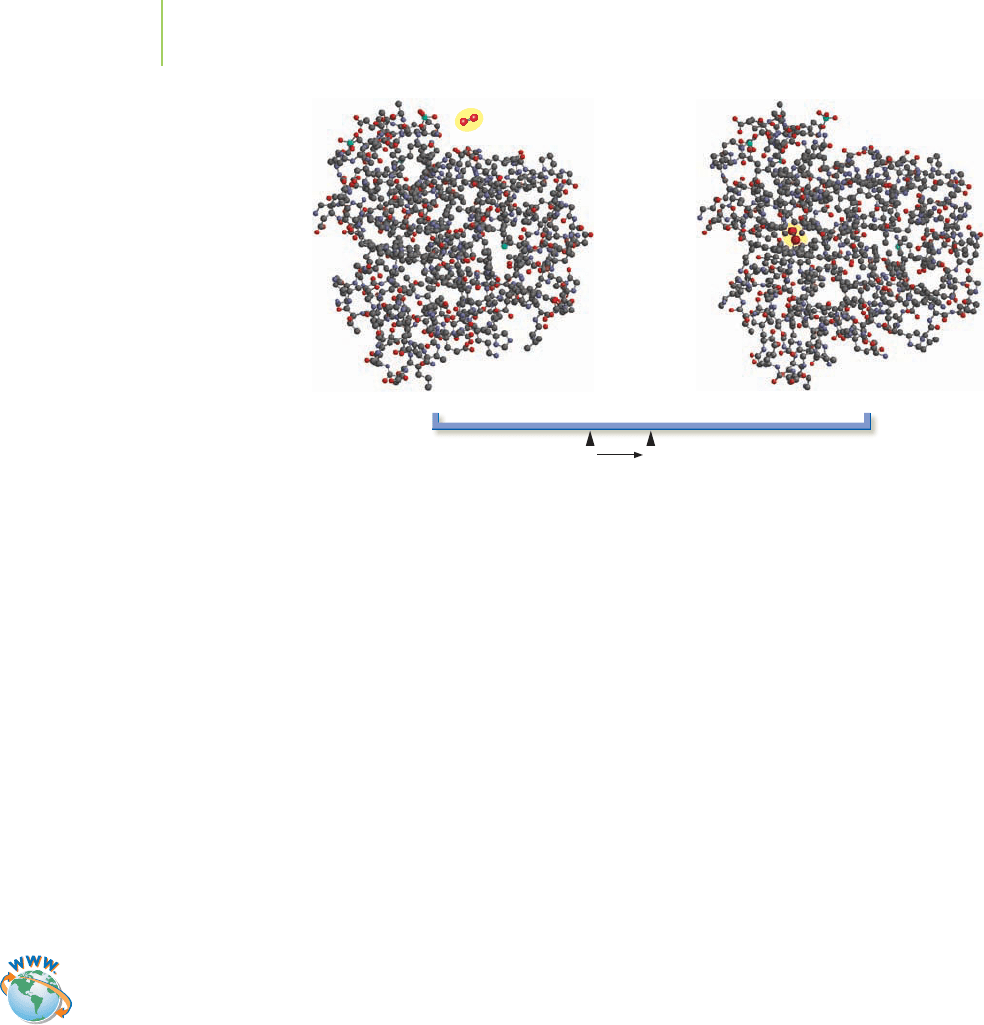Kelter P., Mosher M., Scott A. Chemistry. The Practical Science
Подождите немного. Документ загружается.


require relatively immense myoglobin concentrations to hold needed oxygen for
their extended stays underwater, have levels between about 20 and 70 mg/g, de-
pending on the species.
PRACTICE 16.9
Determine the equilibrium concentration of each compound in the following reac-
tion at 25°C, given the data indicated.
[C
2
H
4
O
2
]
0
= 0 M;[C
2
H
3
O
2
−
]
0
= 0.100 M;[H
+
]
0
= 0.0500 M
C
2
H
3
O
2
−
(aq) + H
+
(aq)
C
2
H
4
O
2
(aq) K = 5.6 × 10
4
(at 25°C)
See Problems 54, 59, 63, 65, 66, and 67.
Intermediate Value of K
Sulfurous acid dissociates in water to produce ions. The equilibrium constant is
not very small, nor is it very large:
H
2
SO
3
(aq)
H
+
(aq) + HSO
3
−
(aq) K = 0.0120 (at 25°C)
Other chemistry also occurs in an aqueous solution of sulfurous acid, including
the ionization of water and the ionization of the HSO
3
−
ion:
H
2
O(l)
H
+
(aq) + OH
−
(aq) K = 1.0 × 10
−14
(at 25°C)
HSO
3
−
(aq)
H
+
(aq) + SO
3
2−
(aq) K = 1.0 × 10
−7
(at 25°C)
The equilibrium constants of these reactions are quite small compared to the ini-
tial ionization of sulfurous acid, so we will focus only on the first equation. Let’s
calculate the equilibrium concentrations of all species. That is, if [H
2
SO
3
]
0
=
1.50 M and [H
+
]
0
= [HSO
3
−
]
0
= 0 M, what is the equilibrium concentration of
each species in solution?
Although the value of K is intermediate (close to 1), we will assume that we
can neglect dissociation of H
2
SO
3
(that is, we assume that the dissociation reaction
does occur but that the change in concentration, “x,” is negligible compared to
the concentrations of our initial substances).
H
2
SO
3
(aq)
H
+
(aq) + HSO
3
−
(aq)
initial 1.50 M 0 M 0 M
change −x +x +x
equilibrium 1.50 − xx x
assumptions 1.50 xx
K =
[H
+
][HSO
3
−
]
[H
2
SO
3
]
0.0120 =
x
2
1.50
x = 0.134 M = [H
+
] = [HSO
3
−
]
Before going on, we must test our assumption that “x” is negligible
compared to 1.50 M, because our assumptions row in the ICEA
table indicates that 1.50 − x = 1.50. We do this by dividing “x”
by 1.50 and multiplying by 100%. Unfortunately, “x” (0.134) is
9% of 1.50! Our assumption is not valid. This suggests that our
698 Chapter 16 Chemical Equilibrium
Reactants
SE
Products

equilibrium line chart might look something like that on page 698 (recall this
same chart from Section 16.3), which shows more than a little forward reaction.
To arrive at the correct answer for this problem, we must solve the problem
explicitly—that is, without making the assumption that the dissociation of
H
2
SO
3
is unimportant compared to its original concentration of 1.50 M. In order
to solve the problem, we must substitute the equilibrium row of our ICEA table
into the mass-action expression:
0.0120 =
x
2
1.50 − x
Unfortunately, the presence of both an “x”and an “x
2
” in the same equation com-
plicates the math somewhat. One useful way to solve for “x” in these situations is
to arrange the values so that we have a
quadratic equation of the general form
ax
2
+bx +c.Forour example,we multiply both sides of the equation by (1.50 −x):
0.0120 × (1.50 − x) = x
2
0.0180 − 0.0120x = x
2
Then we collect all of our terms onto one side of the equals sign by adding
0.0120x and subtracting 0.0180 from both sides of the equation. The result has
set our equation equal to zero:
x
2
+ 0.0120x − 0.0180 = 0
ax
2
+ bx + c = 0
Comparing this to the general form for a quadratic equation, we obtain the val-
ues for the constants a, b, and c:
a = 1; b =+0.0120; c =−0.0180
Some programmable calculators will solve for the values of “x” in the equation by
entering the constants a, b, and c. The other, perfectly satisfactory option is to
employ the
quadratic formula, the equation used to solve for “x”:
x =
−b ±
√
b
2
− 4ac
2a
Inserting our values for a, b, and c into this equation and solving, we obtain two
values for x:
x =
−b ±
√
b
2
− 4ac
2a
x =
−0.0120 ±
(0.0120)
2
− 4(1)(−0.0180)
2(1)
x =
−0.0120 ±
√
0.000144 +0.072
2(1)
x =
−0.0120 ±0.2686
2(1)
x = 0.128, −0.140
The existence of two values for “x” would appear to be a problem. However, it
is not. One of these values gives equilibrium concentrations that are physically
16.5 Solving Equilibrium Problems—A Different Way of Thinking 699
Video Lesson: An Equilibrium
Problem Using the Quadratic
Equation
Video Lesson: Common
Mathematical Functions

700 Chapter 16 Chemical Equilibrium
impossible to obtain. Let’s determine the concentrations in both cases and see
why only one works:
If “x” =−0.140, then
[H
2
SO
3
] = 1.50 + 0.140 = 1.64 M;[H
+
] = [HSO
3
−
] =−0.140 M
If “x” = 0.128, then
[H
2
SO
3
] = 1.50 − 0.128 = 1.37 M;[H
+
] = [HSO
3
−
] = 0.128 M
When “x” =−0.140, we obtain negative values for both [H
+
] and [HSO
3
−
]. This
is impossible, so “x” must be 0.128. The correct answer to this problem must be
[H
2
SO
3
] =1.37 M and [H
+
] =[HSO
3
−
] =0.128 M. Using these values, we need
to check our answer:
K =
(0.128)
2
1.37
= 0.0120
The invalid answer from the quadratic equation will generate a negative value for
a concentration. We must never assume, however, that a negative value of “x” will
always produce the invalid answer. In the end, the key to doing equilibrium prob-
lems is to make assumptions when you can to simplify the math. However, you
must test the assumptions that you make. When the assumptions fail, we use the
equilibrium row in the ICEA table to solve for “x” explicitly.
In Summary
We have seen that our ability to interpret the meaning of equilibrium constants
and to make assumptions that simplify our problem solving are the ideas at the
core of this different way of thinking about chemistry. We raised five questions at
the beginning of this section:
What chemical reactions will occur?
Which among these are important? Which are unimportant?
Given the initial concentration of substances, in which direction
(toward the formation of more reactants or toward the formation of
more products) is the reaction likely to proceed?
How can we solve for the amounts of substances of interest that are
present at equilibrium?
How can we create the conditions to maximize the concentration of
the desired components and minimize that of the others?
We have now answered the first four of these questions. We are now ready for
question 5, which concerns the human control of chemical processes—one big
payoff of our study of equilibrium.
16.6 Le Châtelier’s Principle
We have discussed understanding chemical equilibrium as “a different way of
thinking.”
Le Châtelier’s principle, described by Henry Louis Le Châtelier
(1850–1936; Figure 16.10) in 1884, extends this to changes in a system at equilib-
rium. Its implications are profound. This useful principle can be summarized as
follows: If a stress is applied to a system at equilibrium, it will change in such a way as
to partially undo the applied stress and restore the equilibrium. Although the system
moves back toward its original set of equilibrium conditions, it never quite makes
it, so there is a net change (often substantial) in equilibrium concentrations as a
5
4
3
2
1
FIGURE 16.10
Henry Louis Le Chaˆtelier (1850–1936), a
French chemist, was a mining engineer
before working as a professor. In addition
to inspiring his work on thermodynamics,
his interest in high temperatures, dating
from his studies of mineralogy, led to the
development of the oxyacetylene torch
for cutting and welding steel.
Tutorial: Le Cha
ˆ
telier’s Principle
Visualization: Le Cha
ˆ
telier’s
Principle
Video Lesson: Le Cha
ˆ
telier’s
Principle
Video Lesson: CIA
Demonstration: Shifting the
Equilibrium of FeSc
n
2+

result of changes in the system. For people, the equivalent saying might be “Push
me and I’ll push back.” This is shown graphically in Figure 16.11.
This principle has several implications for a system at equilibrium:
■
If the concentration of a component is changed, the system will respond in
such a way that the concentration returns toward (but doesn’t make it to) its
original equilibrium value.
■
If the pressure of a system is changed, it will respond in such a way as to return
the pressure toward (but not to) the original equilibrium value.
■
If the temperature of a system is changed, it will respond by exchanging heat
such that the temperature returns toward the original equilibrium value.
Let’s look at the effect on equilibrium of each of these changes—concentration,
pressure, and temperature—in more detail.
Changes in Concentration
If the concentration of a component is changed, the system will respond in such a way
that the concentration returns toward its original equilibrium value. We began this
chapter by discussing the interaction of oxygen and myoglobin to form a com-
plex that stores and transports oxygen within muscle cells. How is the control of
oxygen levels in the muscle cells indicative of this statement of Le Châtelier’s
principle? Let’s look at it mathematically, using two separate sets of conditions.
We saw one set of equilibrium conditions in Exercise 16.9. Recall the data for the
reaction:
Mb + O
2
MbO
2
K = 8.6 × 10
5
[Mb] = 1.8 × 10
−4
M;[O
2
] = 1.2 × 10
−7
M; [MbO
2
] = 1.9 × 10
−5
M
Let’s change the conditions so that the oxygen level in the blood increases to
1.0 × 10
−5
M. How will the system respond to this change? We can use our reac-
tion quotient, Q, to determine which way the reaction will go to reestablish
equilibrium.
Q =
[MbO
2
]
0
[Mb]
0
[O
2
]
0
=
(1.9 ×10
−5
)
(1.8 ×10
−4
)(1.0 ×10
−5
)
= 1.1 × 10
4
Because Q < K, the reaction will shift to the right (see Section 16.5) to produce
more product and reduce the concentration of the reactants. Let’s solve for the
concentrations of myoglobin, oxygen, and the MbO
2
complex at this new equi-
librium position. The ICEA table can be set up as follows:
Mb + O
2
MbO
2
initial 1.8 × 10
−4
M 1.0 × 10
−5
M 1.9 × 10
−5
M
change −x −x +x
equilibrium 1.8 × 10
−4
− x 1.0 × 10
−5
− x 1.9 × 10
−5
+ x
When we solve, we find that “x” = 9.8 × 10
−
6
M,and
[Mb]
new
= 1.7 × 10
−4
M;[O
2
]
new
= 2.0 × 10
−7
M; [MbO
2
]
new
= 2.9 × 10
−5
M
compared to the starting position,
[Mb]
0
= 1.8 × 10
−4
M;[O
2
]
0
= 1.0 × 10
−5
M; [MbO
2
]
0
= 1.9 × 10
−5
M
The reactant concentrations (myoglobin and oxygen) have decreased, and the
concentration of the product (the myoglobin–oxygen complex) has increased.
We added more reactant and the system shifted to the right to make more
16.6 Le Châtelier’s Principle 701
FIGURE 16.11
Le Chaˆtelier’s principle is somewhat anal-
ogous to this situation. The wrestler in
red pushes the defender out of position
(applying a stress). The defender pushes
back, trying to restore his original posi-
tion, but not fully succeeding.
Video Lesson: The Effect of
Changing Amounts on
Equilibrium
Video Lesson: CIA
Demonstration: Silver Chloride
and Ammonia

Reactants
SE
Products
702 Chapter 16 Chemical Equilibrium
product. In the end, the system moved to restore the equilibrium. In our human
analogy, the system was pushed and it pushed back. A snapshot of the changes on
our equilibrium line chart is shown above.
During exercise, the body uses large amounts of oxygen. Some of that oxygen
is supplied by the equilibrium position shifting to the left, in response to the fall
in free oxygen levels that occurs because so much oxygen is being consumed. This
releases more oxygen and free myoglobin, enabling athletes to run freely, for ex-
ample. When the need for oxygen is less, the free myoglobin combines with oxy-
gen (the reaction shifts to the right) and forms more of the MbO
2
complex. The
complex can act as a storage location for oxygen, making it ready for release when
it is needed.
Concentration changes make possible the industrial-scale manufacturing of
chemicals. As the chemicals are produced in a reaction, they are removed, forcing
the reaction to produce products continually in an “attempt” to restore the origi-
nal equilibrium position. This is an important part of the contact process, in
which the SO
3
that is produced from the reaction of SO
2
and O
2
is continually
removed, forcing continued production of SO
3
.
Changes in Pressure
If the pressure of a system is changed (at constant temperature and volume), it will
respond in such a way as to return the pressure toward the original equilibrium
value.
To illustrate the importance of this statement of Le Châtelier’s principle, let’s
look at a reaction in which changes in pressure are meaningful—one that in-
volves gases. Recall the reaction for the manufacture of ammonia from hydrogen
and nitrogen via the Haber process:
3H
2
(g) + N
2
(g)
2NH
3
(g)
If the pressure of the system is substantially increased from 1 atm to 300 atm, how
will it respond? The system will shift in a direction that will lower the pressure to-
ward the original equilibrium value. Recall from our discussion of gases (Chap-
ter 10) that the pressure of a gas is approximately proportional to the number of
moles of a real gas. Fewer moles means lower pressure, so the reaction used in the
Haber process will shift to the right when the pressure is increased. Typically,
we observe changes in volume as the reaction seeks to accommodate pressure
changes. As the volume is decreased, the pressure increases, and as the volume is
increased, the pressure decreases.
An increase in pressure favors the side with fewer moles of gas.
A decrease in pressure favors the side with more moles of gas.
Video Lesson: The Effect of
Pressure and Volume on
Equilibrium
Visualization: Equilibrium
Decomposition of N
2
O
4
Video Lesson: CIA
Demonstration: NO
2
/N
2
O
4

How does this help in the manufacture of ammonia? Table 16.2 shows
the mole percent of ammonia present at equilibrium at various pres-
sures for the Haber process.
At every temperature, higher pressure means a shift toward ammo-
nia. In practice, the industrial manufacture of ammonia is done
between 100 and 300 atm.
Changes in Temperature
The reaction for the manufacture of ammonia is exothermic:
3H
2
(g) + N
2
(g)
2NH
3
(g)
H
◦
=−92.0 kJ
How will the system respond if the temperature is raised from 200
o
C
to 500
o
C at constant pressure? The change in enthalpy for the forma-
tion of ammonia is negative. Therefore, the reaction gives off heat.
What shift is necessary to attempt to restore the original temperature of
the system?
The reaction will proceed in the direction that absorbs heat
(“attempting” to lower the temperature) rather than proceeding in the direction
that releases more heat, which would raise the system temperature. In the forma-
tion of ammonia, equilibrium would be restored with a shift to the left resulting
in the formation of more reactants.
Exothermic reactions shift toward the left (the reactants side) when heated. (Note
that this can be seen in Tables 16.2 and 16.3.)
Endothermic reactions shift toward the right (the products side) when heated.
There is another implication to the shift that occurs when a system at equi-
librium is heated or cooled. The temperature itself is changing the concentrations
of the components in the equation. The system is responding and we aren’t
adding or removing a component. This can happen only if the equilibrium con-
stant itself changes with temperature. As we noted in Exercise 16.10, equilibrium
constants are temperature dependent. Table 16.3 shows the change in K
p
at vari-
ous temperatures for the exothermic contact process addition of oxygen to SO
2
to
form SO
3
. Although the data in the table show that the value of K decreases as the
temperature increases, there are many cases where K increases with increasing
temperature. The direction of the change is dependent on the enthalpy of the
process.
16.6 Le Châtelier’s Principle 703
Mole Percent of Ammonia Present at Various Pressures andTemperatures
Pressure (atm)
1 10 50 100 300 1000
Temperature (
o
C)
200 15.3 50.7 74.4 81.5 89.9 98.3
400 0.4 3.9 15.3 25.1 47.0 79.8
600 ––– 0.5 2.3 4.5 13.8 31.4
Source: Hocking, M. B., Handbook of Chemical Technology and Pollution Control; Academic
Press: New York, 1998, p. 313.
TABLE 16.2
Dependence of the Equilibrium
Constant (K
p
) on Temperature
2SO
2
(g) + O
2
(g)
2SO
3
(g) ∆H = –198 kJ
Temperature (°C) K
p
400 1.6×10
5
500 2.3×10
3
600 91
700 6.9
800 0.84
900 0.15
1000 0.034
1100 0.0096
TABLE 16.3
Source: Based on data from Hocking, M. B., Handbook of
Chemical Technology and Pollution Control; Academic
Press: New York, 1998, p. 260.
Reactants
E
Products
For an exothermic reaction
Low T
Reactants
E
Products
High T
Reactants
E
Products
For an endothermic reaction
Low T
Reactants
E
Products
High
T
The position of equilibrium and, hence,
the value of the equilibrium constant
change when the temperature of the
reaction is changed. The value of the
equilibrium constant of an exothermic
reaction decreases with an increase in
temperature; the value of the equilibrium
constant of an endothermic reaction
increases with an increase in temperature.

A look at metal catalysts through a
scanning electron microscope reveals a
porous crystal surface.
Application
C
HEMICAL
ENCOUNTERS:
Catalysts in
Industry
The Importance of Catalysts
Economics plays an important part in the chemical industry. A production
process that reaches equilibrium more rapidly will allow more product to
be manufactured. More product means the opportunity for increased sales.
Catalysts—substances that substantially increase the rate of a reaction without
being consumed—are therefore vital to the chemical process industries.
A catalyst does not affect the equilibrium position, but it allows the process to achieve
equilibrium more rapidly than it would without a catalyst.
Fritz Haber used magnetite (Fe
3
O
4
) for the preparation of ammonia. Iron-related
catalysts are still used for ammonia production (via the Haber process), although
other metals can also be used, including osmium and mixtures of ruthenium and
barium.
The nitrogen gas used in the synthesis of ammonia is obtained by distilling
liquid air. The hydrogen gas for the Haber process is derived from the iron(II)
oxide– and chronium(III) oxide–catalyzed reaction of carbon monoxide (de-
rived from coal tar) with water. The equation illustrating the formation of hy-
drogen by this method is
CO(g) + H
2
O(g)
FeO +Cr
2
O
3
CO
2
(g) + H
2
(g) (500
o
C)
The nickel-catalyzed reaction of methane (from natural gas) and water vapor
also produces hydrogen:
CH
4
(g) + H
2
O(g)
Ni, 400 psi
CO(g) + 3H
2
(800
o
C)
This means that when the price of coal or natural gas rises, the cost of fertilizer
can rise as well. This is another example of the relationship between industrial
chemical processes and international economics.
The Contact process uses vanadium(V) oxide on pumice as the catalyst for
the conversion of SO
2
to SO
3
. Although the catalyst can last for up to 20 years, re-
placing it each year helps ensure efficiency in the reaction. Platinum is a better
catalyst but costs much more. Platinum catalysts can also become less effective in
the presence of impurities such as arsenic.
EXERCISE 16.10 Le Châtelier’s Principle
The reaction for the combination of hydrogen gas and oxygen gas to give water
vapor is
2H
2
(g) + O
2
(g)
2H
2
O(g)
H
◦
=−484 kJ
Predict the effect of each of these changes to the system on the direction of
equilibrium.
a. H
2
O is removed as it is being c. The pressure on the system is
generated. decreased.
b. H
2
is added. d. The system is cooled.
Solution
a. Moves to the right (removal of product forces Q to be less than K, and the sys-
tem compensates by making more product).
b. Moves to the right (same as above, except Q is less than K because [H
2
]
0
is
larger than at the previous equilibrium).
c. Moves to the left because decreasing the pressure favors the side with more
moles of gas.
d. Moves to the right because an exothermic reaction gives off heat. Cooling the
system increases the temperature gradient between the system and the sur-
roundings, therefore allowing a continued flow of heat to the surroundings.
704 Chapter 16 Chemical Equilibrium
Video Lesson: The Effects of
Temperature and Catalysts on
Equilibrium

16.7 Free Energy and the Equilibrium Constant
We introduced the relationship between free energy and the reaction quotient, Q,
in Section 14.6 of our thermodynamics chapter. We listed the quantitative
relationship as
∆G = ∆G° + RT lnQ
where ∆G =the free energy of the reaction
∆G° = the free energy at standard conditions
R = the universal gas constant, 8.3145 J·mol
−1
·K
−1
T = the temperature in kelvins
Q = the reaction quotient illustrating the current concentrations
in the reaction
16.7 Free Energy and the Equilibrium Constant 705
PRACTICE 16.10
Predict the effect of each of these changes to the following system on the direction
at equilibrium.
2C
2
H
6
O(aq) + 2CO
2
(g)
C
6
H
12
O
6
(aq) ∆H = 70.0 kJ/mol
Ethanol Glucose
a. Heat is added.
b. Some ethanol (C
2
H
6
O) is removed from the reaction.
c. A catalyst is added.
d. More glucose is added to the flask.
See Problems 69, 70, and 74.
Le Châtelier’s principle is one of the most important ideas in all of chemistry.
Through its application, we understand and control reactions that have the most
far-reaching importance, from the essential reactions in the human body to the
production of billions of kilograms of material goods used in everything from
fertilizers to plastics. Table 16.4 summarizes the impact of changing the concen-
tration, pressure, or temperature, as well as the impact of the addition of a cata-
lyst, on the direction of chemical equilibria.
Impact of External Changes on the Equilibrium Direction
Change System Response Change in K
Concentration Shifts toward restoring initial concentration None
Pressure (of the system)
Increase Shifts toward side with fewer moles of gas None
Decrease Shifts toward side with more moles of gas None
Temperature
Exothermic Raising temperature shifts toward reactant Decreases
reaction Lowering temperature shifts toward product Increases
Endothermic Raising temperature shifts toward product Increases
reaction Lowering temperature shifts toward reactant Decreases
Catalyst No change in direction; reaches equilibrium None
more rapidly
TABLE 16.4

Our thermodynamic definition says that at equilibrium, ∆G = 0. Therefore, at
equilibrium, the reaction quotient, Q, becomes the thermodynamic equilibrium
constant, K
eq
.
0 = ∆G° + RT ln(K
eq
)
Solving for ∆G°, we obtain
∆G° =−RT ln(K
eq
)
This equation is very useful. It enables us to calculate the equilibrium constant for
a process if we know the standard free energy change for that process.
One word of caution is needed. The equilibrium constant in this equation re-
quires that we use its thermodynamic definition. This means that all concentra-
tions in the mass-action expression must be expressed in activities and that all
gases must be expressed in fugacities (f ). A fugacity is similar to an activity in that
it measures the effective pressure of a gas. To simplify this, we’ll assume that
the activity values are close to the values of concentration expressed in molarity
and that the fugacity values are close to the values of pressure expressed in at-
mospheres. Let’s write the equilibrium constant expression for the environmen-
tal leaching of lead into acidic waters in order to illustrate this definition.
PbCO
3
(s) + 2H
+
(aq)
Pb
2+
(aq) + CO
2
(g) + H
2
O(l)
K
eq
=
a
Pb
2+
f
CO
2
a
H
2
O
a
PbCO
3
a
2
H
+
≈
[Pb
2+
]P
CO
2
[H
+
]
2
where:
a
Pb
2+
≈ [Pb
2+
] and
a
2
H
+
≈ [H
+
]
2
f
CO
2
≈
P
CO
2
(the partial pressure of CO
2
) in atmospheres
a
PbCO
3
≈ 1.0 and
a
H
2
O
≈ 1.0
In this equation, PbCO
3
is a solid and H
2
O is a liquid. As with K and K
p
, we con-
sider their activity to be 1.0 and their concentration to be part of the equilibrium
constant. As before, we simply remove them from the equation.
EXERCISE 16.11 Free Energy and the Equilibrium Constant
Using the standard free energy values given below, calculate the equilibrium con-
stant at STP for the formation of SO
3
(g).
2SO
2
(g) + O
2
(g)
2SO
3
(g)
G
◦
(kJ/mol) −300 0 −371
Solution
rxn
G
◦
= ∆G°
products
− ∆G°
reactants
= 2(−371 kJ/mol) − 2(−300 kJ/mol)
reaction
G
◦
=−142 kJ/mol
In order to cancel units properly, we must convert
reaction
G
◦
to J/mol.
reaction
G
◦
=−142,000 J/mol
∆G° =−RT ln(K
eq
)
−142,000 J/mol =−8.3145 J
·
mol
−1
·
K
−1
(298 K)ln(K
eq
)
ln(K
eq
) =
−142,000 J·mol
−1
−8.3145 J·mol
−1
·K
−1
(298 K)
= 57.31
706 Chapter 16 Chemical Equilibrium

We can take the inverse natural log of both sides.
K
eq
=
e
57.31
= 7.76 ×10
24
When we compare this value to the value we mentioned for the reaction at 400°C
(K = 8.7 × 10
6
), we notice that it is different. Why is it different? The equilibrium
constant is highly temperature dependent. We’ve calculated it at 25°C, and so it
should be different from K at 400°C.
PRACTICE 16.11
Use the thermodynamic data in the appendix to calculate the equilibrium constant
for the ionization of sulfurous acid.
H
2
SO
3
(aq)
H
+
(aq) + HSO
3
−
(aq) K = 0.0120 (25
o
C)
How does the calculated value for K
eq
compare to the value of K reported here?
Explain any differences.
See Problems 77–82.
We will apply the concepts we learned in this chapter (including the nature of
equilibrium, our new way of thinking about problem solving, and Le Châtelier’s
principle) to look at aqueous equilibria. Our immediate focus will be on a most
important set of reactions—acid–base equilibria.
The Bottom Line 707
The Bottom Line
■
Reactions can proceed reversibly toward the prod-
ucts or back toward the reactants. (Section 16.1)
■
The point in a reaction at which there is no net
change in the concentration of reactants or products
is known as chemical equilibrium—or, often, simply
as equilibrium. (Section 16.1)
■
The free energy, G, of a reaction is at a minimum at
equilibrium. (Section 16.1)
■
The free energy change, ∆G, is equal to 0 at equilib-
rium. (Section 16.1)
■
The rates of the forward and reverse reactions are
equal at equilibrium. (Section 16.1)
■
The mass-action expression relates the equilibrium
concentrations of reactants and products in a reac-
tion. (Section 16.1)
■
The equilibrium constant is temperature dependent.
(Sections 16.1, 16.6)
■
The size of the equilibrium constant gives us infor-
mation about the extent of a reaction. (Section 16.3)
■
Modifying the coefficients of a reaction modifies the
value of its equilibrium constant. (Section 16.4)
■
The equilibrium constant can be converted for use
with partial pressures or molarities. (Section 16.4)
■
The equilibrium constant for the sum of chemical
reactions is the mathematical product of the individ-
ual K values. (Section 16.4)
■
We can use the equilibrium constant and mass-
action expression to calculate the equilibrium con-
centration of substances in a reaction. (Section 16.5)
■
Solving problems relating to reaction equilibria in-
volves asking and answering a series of systematic
questions. (Section 16.5)
■
We can use the reaction quotient, Q, to assess which
way a reaction will proceed to reach equilibrium.
(Section 16.5)
■
Le Châtelier’s principle concerns the impact of
changing the pressure, temperature, and concentra-
tion conditions of a reaction at equilibrium.
(Section 16.6)
■
A catalyst does not affect the equilibrium position. It
changes the reaction mechanism in such a way as to
speed up the reaction. (Section 16.6)
■
The free energy change of a reaction can be deter-
mined from the equilibrium constant for that reac-
tion and vice versa. (Section 16.7)
